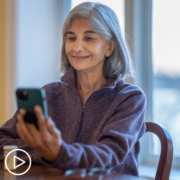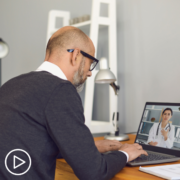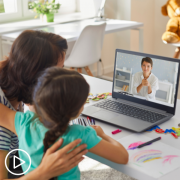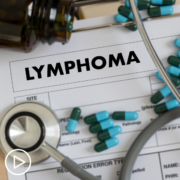What Are Potential Telemedicine Risks for Myeloproliferative Neoplasm Patients?
What Are Potential Telemedicine Risks for Myeloproliferative Neoplasm Patients? from Patient Empowerment Network on Vimeo.
What risks should myeloproliferative neoplasm (MPN) patients be aware of with telemedicine? Experts Dr. AnaMaria Lopez from Sidney Kimmel Cancer Center, Dr. Krisstina Gowin from University of Arizona Cancer Center, and patient Lisa Hatfield share their perspectives and advice. Watch as they discuss potential risks in MPN patient care, how to advocate for the continuation of telemedicine, and advice for patients to work toward optimal wellness.
See More from MPN TelemEDucation
Related Resources:

How Can Myeloproliferative Neoplasm Patients Use Integrative Health? |

|

|
Transcript:
Lisa Hatfield:
Are there any risks or drawbacks that you see to telehealth or telemedicine for digital health?
Dr. AnaMaria Lopez:
The most important thing is to remember that the technology is a tool, and if the person feels that there’s a limitation, so, for example, if the patient is seen and they say their heart is racing or skipping beats or something, now, there are ways, there are electronic stethoscope, so you can really do a full exam except for palpation through telemedicine. But not everybody has that even in a clinic, but certainly in our own home, we don’t have that technology. So if a patient is expressing a concern for which the clinician really feels that needs a closer evaluation, then that’s the right next step, so we’re not…the technology is a tool to help us care for people, and if it’s not all available right there, then we need to see the patient in person. So I think that’s the risk is just sometimes people may feel limited like, “Oh, well, I’m not really sure It’s okay, I’m not really sure I need to see you, or you need to go here or go there for the care.”
And the other, which is a really big threat, is that part of the reason we did 70 years work in a couple months is because it was reimbursed, and we’re reaching the end of the pandemic, the federal…and with that, the payers may go backwards. We all know that if that happens, we will go backwards in telemedicine. [chuckle] There will just be decreased, decreased use. And it may lead to people then going back to traveling for four hours, waiting, only to be told, “Oh, you know what? There’s not this. This clinical trial doesn’t work for you.” So we don’t want to lose ground. And part of not losing ground is that we really need to continue to have advocacy around reimbursement.
Lisa Hatfield:
Thank you, Dr. Lopez. And I feel compelled, just to follow up with one more question regarding that, because I’m very passionate about this. With some of these rules and guidelines coming to an end, I know in my particular state that I will no longer be able to access my specialist. I see a myeloma specialist. We do not have any here locally. I can access a specialist via telemedicine. I will not have that opportunity. So as all of us know, there are disparities and there are financial disparities in cancer patients. There are racial disparities in cancer patients, there are socioeconomic disparities. Telemedicine has been a tremendous…has had a tremendous impact on the care and the outcomes and the quality of life of so many patients. So as a patient and as an advocate, do you have any recommendations? Do I go to my doctor and say, “Okay, how can I move forward and still talk to my specialist, who’s out of state? Do I go to my state legislature? Do I talk to my insurance company? How can we get this to continue?” Because this has had such a significant impact on the quality of life and on the outcomes for patients, who otherwise, would not have been able to access that care.
Dr. AnaMaria Lopez:
Yeah, I mean, I think all of the above. Partnering with other advocates, the American Telemedicine Association has a map that kind of says where are all the shifting sands regarding the different rules and legislative changes. But I think it’s led us to a place, where we are all advocates and where physicians, nurses, patients, pharmacists, everybody in the same way that we do team-based care, that we do team-based advocacy and it’s all for our patients.
Lisa Hatfield:
Great. Thank you for that. Dr. Gowin, any last words that you may have about accessing specialists or telemedicine options?
Dr. Krisstina Gowin:
Well, I think we covered the basics, but I just want to end with just how empowering the access to digital health interventions really is. And so I don’t think there is a one-size-fits-all approach to every patient. So what I would encourage patients to do is just to really think, “How do I compliment my care? What am I missing? How do I achieve my best wellness? And how do I get those resources in my home to make them more convenient for me?” And to start doing some research and self-advocacy to really get those resources because they are out there and in almost…in every domain, there is now a digital version that is accessible to you now.
Share Your Feedback:
Create your own user feedback survey










